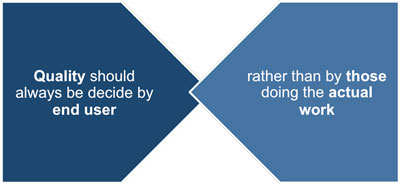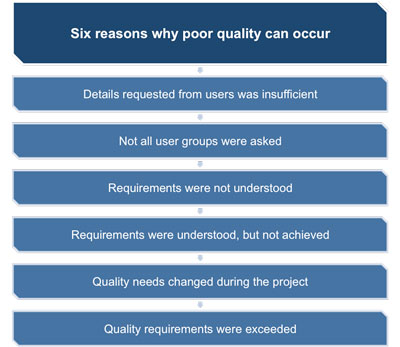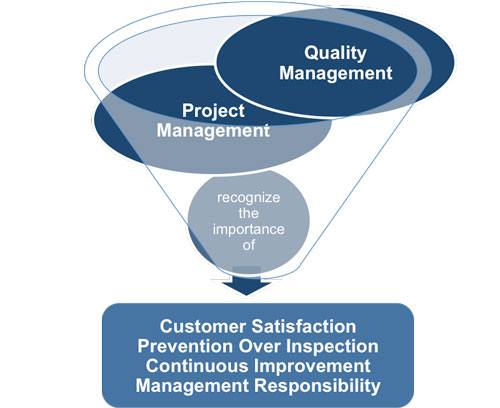Managing Project Quality
Quality management includes the processes and activities of the performing organization that determine quality policies, objectives, and responsibilities so that the project will satisfy the needs for which it was undertaken.
It implements the quality management system through policy and procedures with continuous process improvement activities conducted throughout, as appropriate. Quality management, like every other aspect of the project management, should be proactive. Limiting the quality management to detecting defects is reactive. You should plan the quality and prepare an environment that does not create defects, instead of finding and repairing defects.
Many people who are new to project management find it strange that quality is treated as a separate area. Surely, quality should be present in every aspect of the project. This way of thinking begs the question, why is quality treated as something that can be managed separately? To answer this, we need to define exactly what we mean by 'quality' and who gets to decide what this definition is.
In some situations a quality standard might be obvious, for example a computer system used by customer service staff must be able to deal with peak loads. In this case, a quality standard could specify that when one hundred staff are inputting data at the same time, the system response time must still be less than two seconds.
 |
However quality is not always quite so easy to define; consider the design of the computer interface to capture customer data.
The software engineer responsible for the design might consider conformance to industry standards to be a sign of quality.
The user might consider it more important that the design matches the interfaces that they already use.
In this example, it is more important that the users will be able to work more efficiently than that the design conforms to some theoretical external standard. In fact, it should always be the end user who decides what counts as quality rather than the people doing the work. Although this can be complicated when a project has a number of users who have different priorities.
In the example we have been using, it may be important for customer service staff who deal with billing to see a summary of the past two years of payment history on the 'home' screen whereas staff who deal with complaints might prefer to see the complaint history. Focusing too much on one group of users may compromise the others and leave them dissatisfied. This illustrates one reason why a system to manage quality is required.
 |
There are six possible reasons why quality standards might not be met despite everyone on the project team doing their best to deliver the project as specified.
1. The users were not asked to specify their requirements in sufficient detail
2. Not all of the user groups were asked
3. The requirements were not understood
4. They were understood but could not be achieved
5. The quality requirements changed during the project
6. The quality requirements were exceeded
The first five points are easily understandable, but the last one needs some explanation. If quality requirements have been exceeded then someone somewhere has done more work than has been planned for in that part of the project.
This work needs to be paid for, in either time or money and this has not been budgeted for. Because there is a lag when comparing actual progress against planned progress and for money actually spent against the budget, this is not usually obvious at the time.
The result of exceeding the quality plan is that sooner or later either more money needs to found or the scope of the project needs to be reduced. Neither of these things is acceptable.
The purpose of quality management is to make sure that the project meets the needs for which it was created. To do this it needs to take account of the reasons above why it might not. It needs to ensure that:
1. Users are asked to specify their requirements in sufficient detail
2. Requirements are fully documented
3. All stakeholders agree to them
4. There is a recognized process to deal with any changes
5. There is a process for monitoring and controlling quality
Modern quality management complements project management and both disciplines recognize the importance of:
Customer Satisfaction
This involves understanding, evaluating, defining, and managing expectations so that customer requirements are met. This requires a combination of conformance to requirements, to ensure the project produces what it was created to produce, and fitness for use (the product or service must satisfy real needs).
Prevention Over Inspection
One of the fundamental tenets of modern quality management states that quality is planned, designed, and built in rather than inspected in. The cost of preventing mistakes is generally much less than the cost of correcting them when they are found by inspection.
 |
Continuous Improvement
The plan-do-check-act cycle is the basis for quality improvement. This is described in detail in the 'Project Management Processes' eBook, which can be downloaded free from this website.
Management Responsibility
Success requires the participation of all members of the project team, but remains the responsibility of management to provide the resources needed to succeed.
You will need to decide what quality means for this particular project and its deliverables. This information makes up the quality plan, which is part of the project plan. Planning for quality is no different from planning for any other task.
 |
It aims to produce a description of what the quality requirements are and how they are going to be achieved. As well as providing a definition of quality the quality plan also acts as a communication tool to engage key stakeholders in the quality management process. You can check out the complete range of project management pdf eBooks free from this website.
A quality plan can be as simple or as detailed as warranted by the project. The plan below is short and simple but it makes it clear to everyone on the project what is expected in terms of quality. In practice, quality planning is inseparable from general planning because quality criteria are required as part of the product descriptions. That is, they need to be thought about when a deliverable is being specified rather than 'added on' afterwards.
Imagine a project to produce a brochure for a new Smartphone. One of the selling points of this new Smartphone model is that it is extremely rugged. The photographs in the brochure need to show the phone being used in various outdoor environments like construction sites and oil rigs. The quality criteria for these photographs might specify that the phone must be clearly identifiable in each photo with the brand name visible.
In another project, one of the final deliverables is a hand held device for scanning barcodes. Quality criteria for this physical product would include things like operational distances from the object being scanned, light levels, acceptable error rates, etc.
 |
Quality criteria should always be used to define the characteristics of a product in terms that are quantifiable and measurable. The criteria effectively define 'quality' and are used as a benchmark against which to measure the finished product.
They should be detailed in the related product description and should be established by considering what the important characteristics of a product are in satisfying the need that it addresses. The quality criteria of a project should always be stated objectively, subjective statements like 'quick response' or 'maintainable' are unsatisfactory because they can't be measured.
You may also be interested in:
Managing Project Quality | Quality Management Techniques | Project Quality Management and ISO Quality Management | Quality Assurance | Quality Control | Testing Project Deliverables | Quality Audits | Post-Implementation Audits.
|
|


